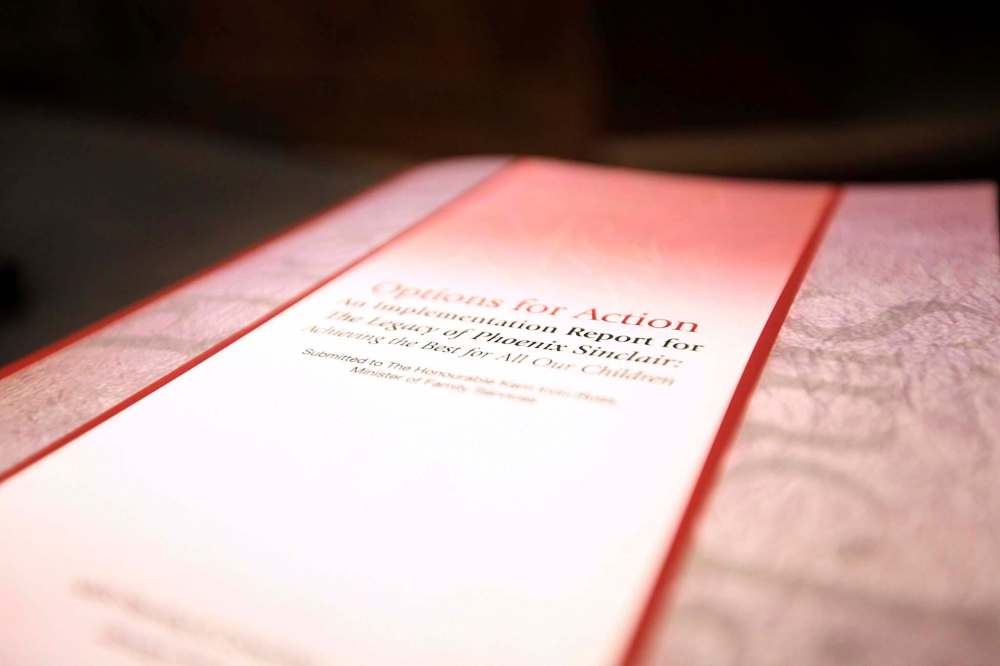CFS system short $104M: report
Funding gap amounts to $12,800 for each First Nations child
Advertisement
Read this article for free:
or
Already have an account? Log in here »
To continue reading, please subscribe:
Monthly Digital Subscription
$0 for the first 4 weeks*
- Enjoy unlimited reading on winnipegfreepress.com
- Read the E-Edition, our digital replica newspaper
- Access News Break, our award-winning app
- Play interactive puzzles
*No charge for 4 weeks then price increases to the regular rate of $19.00 plus GST every four weeks. Offer available to new and qualified returning subscribers only. Cancel any time.
Monthly Digital Subscription
$4.75/week*
- Enjoy unlimited reading on winnipegfreepress.com
- Read the E-Edition, our digital replica newspaper
- Access News Break, our award-winning app
- Play interactive puzzles
*Billed as $19 plus GST every four weeks. Cancel any time.
To continue reading, please subscribe:
Add Free Press access to your Brandon Sun subscription for only an additional
$1 for the first 4 weeks*
*Your next subscription payment will increase by $1.00 and you will be charged $16.99 plus GST for four weeks. After four weeks, your payment will increase to $23.99 plus GST every four weeks.
Read unlimited articles for free today:
or
Already have an account? Log in here »
Hey there, time traveller!
This article was published 19/01/2018 (2885 days ago), so information in it may no longer be current.
OTTAWA — The federal and provincial governments have underfunded First Nation children and young adults in CFS care by $104 million a year, research obtained by the Free Press shows.
For these 8,115 First Nations wards, the 26 per cent shortfall amounts to an average $12,814.42 gap between what governments provide and what agencies say they need to do their jobs properly. They also want another $45 million to reduce the number of children entering the system.
The report was obtained ahead of a summit aimed at reforming a crisis over Indigenous over-representation in Child and Family Services. It shows some social workers are buried under caseloads almost double the ratio set out in an inquiry four years ago.

The report bolsters criticisms of inadequate funding for prevention, which may be leading to more children entering foster care than necessary.
As the Free Press reported last September, Manitoba First Nations child-welfare agencies have been working with Ottawa and the province to bridge discriminatory funding gaps.
In January 2016, a landmark Canadian Human Rights Tribunal ruling found Ottawa was racially discriminating against First Nations children by providing on-reserve CFS agencies less funding than what provinces give off-reserve CFS groups.
In its 2016 budget, the Trudeau government allocated $634 million for First Nations child welfare, but most of it kicks in after the 2019 election. It also put up funding for agencies to survey their funding gaps last summer, based on the issues raised in the tribunal.
A respected demographer crunched the numbers for a report he submitted last October. It’s been widely shared among CFS groups and advocates in the past three months. The Free Press received the report Friday.
Using tribunal criteria, the report reveals the funding gap is 29.2 per cent for children served by the northern Manitoba First Nations group of CFS agencies and 23.9 per cent for the southern regions. Added together, that means a 26 per cent funding gap, with shortfalls by both the federal and provincial governments.
Unlike most provinces, Manitoba has blended the federal dollars allocated for children on-reserve and provincial funding for those living off-reserve. The province provides roughly 60 per cent of the funding, reflecting that only about 40 per cent of First Nations children live on reserves.
Though children and teens in care receive different amounts of funding, calculating the shortfall on a per-capita basis shows the agencies believe First Nations children are each short-changed $12,814.42 annually.
This includes Manitobans who have “extensions of service,” meaning they receive some care after aging out of the child-welfare system at age 18, up to age 21. Many agencies have suggested broadening that category to age 25, in order to help former wards through school and job opportunities.
The agencies are asking for a total of $143 million to $150 million in funding, which includes roughly $45 million to do more prevention work and keep children out of the system, noting the number of children in care keeps rising.
That funding would come in part from the province stopping its claw-back of federal child-care subsidies. It would also account for an anticipated $10-million to $15-million drop in annual costs by 2021 caused by demographics trends in the province’s south. The researchers could not access sufficient data for the north to see whether a similar trend is likely, but they believe it could happen at half the rate in the north, similar to trends observed in Ontario.
Prevention programs account for six per cent of CFS spending in the province’s south, and 9.5 per cent in the north.
The surveys revealed agencies are dipping into budgets used for prevention and family support, in order to keep up with costs of apprehending children, particularly in the southern CFS agencies. Money for apprehensions is automatic, but prevention funding is not “fenced in,” so it can be reallocated to other needs.
That echoes a frequent criticism that the current system gives a perverse incentive for agents to take children into foster homes, instead of helping address root issues.
Opaskwayak Cree Nation CFS appears to be Manitoba’s most underfunded, saying it needs almost 60 per cent more funding to deal with its caseload. As with all agencies, this was an estimate prepared by staff, and vetted by University of Manitoba economics Prof. John Loxley, to be sure their calculations fall within what the tribunal stipulated.
The report reveals Ottawa’s 2016 bump-up, meant to tide over the agencies until it found a solution to the tribunal case, confused social workers.
“It has not addressed funding gaps and deficiencies. It was arrived at without consultation,” the report summarizes.
Many agencies saw the top-up as an election ploy because most of the funding arrives after the 2019 vote.
“It is not based on agency needs, capacities or abilities and it ignores what could be accomplished if more rapid spending enlarged those capacities and abilities.”
A spokeswoman for Indigenous Services Minister Jane Philpott said the top-up was based on a CFS national advisory council recommendation. “The department is committed to respond to this and other input from partners about how best to improve the funding approach,” Valérie Haché wrote.
Agencies were critical of the provincial policy of clawing back four per cent of salary budgets to account for vacancies; the agencies claim their turnover is half that amount.
They also believe salaries are budgeted based on mid-career compensation, when many can only hire staff with more experience and thus a higher salary.
The Phoenix Sinclair inquiry prescribes that CFS workers have one staff member for every 20 children in care, but some agencies have a staffing ratio of 1:35. The Awasis agency gets enough staff funding to handle just 700 of the 1,600 cases it administers — though it still gets per-capita foster-care funding. Five-year-old Phoenix Sinclair was slain by her mother and stepdad in 2005.
The report did not examine Manitoba’s other two CFS authorities: the general one, which handled 1,937 non-Indigenous children in 2016, nor the 1,220 cases under the Métis CFS authority.
On Wednesday, Philpott will convene an emergency meeting in Ottawa with Indigenous and provincial officials, in the hopes of reforming child welfare.
She has said more funding to address the gap would be in the spring budget.
dylan.robertson@freepress.mb.ca
History
Updated on Saturday, January 20, 2018 8:11 AM CST: Edited
Updated on Saturday, January 20, 2018 12:56 PM CST: Subhead changed.


